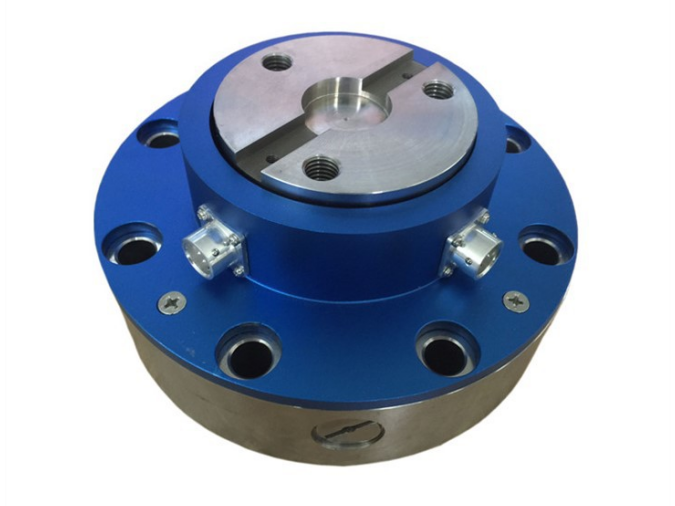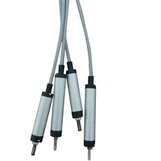BRG62150 Dual Range Static Torque Transducer
When a single large-range torque sensor performs a small-range torque test, the test error is large, which makes the test result worthless. In response to this problem, we divide the elastic body of the large-range torque sensor into dual-ranges. When performing a small torque test, the test range is automatically switched to the small-range file by pressing the key to ensure more accurate test results.

Features
1. Resistance strain type principle, high precision, stable and reliable performance, large range torque measurement, easy installation and use.
2. Dual range static torque measurement.
3. One end is the key flange connection, and the other end is the flange connection.
4. Can measure the torque in both directions
5. Suitable for measurement of large and small double-range static torque
Technical Parameters
|
parameter |
Technical index |
|
parameter |
Technical index |
|
range |
0-20, 100, 1000, 5000Nm |
Response frequency |
100μS |
|
|
Sensitivity |
1.5±10% mV / V |
Insulation resistance |
≥5000MΩ/ 100VDC |
|
|
Zero output |
±1% F.S. |
Excitation voltage |
10VDC-15VDC |
|
|
Non-linear |
±0.1, 0.3% F.S. |
Temperature compensation range |
-10 ~ 60℃ |
|
|
Hysteresis |
≤±0.05% F.S. |
working temperature |
-20 ~ 65℃ |
|
|
Repeatability |
≤±0.05% F.S |
Safety overload |
150% F.S. |
|
|
Creep |
≤±0.03% F.S/30min |
Extreme overload |
200% F.S. |
|
|
Temperature sensitivity drift |
0.03% F.S. / 10℃ |
Cable size |
Ø5.2×3m |
|
|
Zero temperature drift |
0.03% F.S. / 10℃ |
Electrical connections |
red/E+, black/E-, green/S+, white/S- |
|
|
Input resistance |
750±10Ω |
Material |
Aluminum, stainless steel or alloy steel |
|
|
output resistance |
700±5Ω |
other request |
customizable |
Dimension (mm)

|
Model |
Short Range(Nm) |
Long range(Nm) |
φA |
φD |
φE |
φF |
φG |
B |
C |
P |
φR |
φH |
Φn1 |
Φn2 |
T |
M |
|
BRG-2150 |
20 |
500 |
158 |
98 |
78 |
27 |
120 |
74 |
40 |
3 |
60 |
138 |
8-φ11 |
8-φ17 |
10 |
3-M10deep18 |
|
BRG-2151 |
30 |
1000 |
158 |
98 |
78 |
27 |
120 |
74 |
40 |
3 |
60 |
138 |
8-φ11 |
8-φ17 |
10 |
3-M10deep18 |
|
BRG-2152 |
100 |
3000 |
195 |
108 |
89 |
37 |
142 |
100 |
52 |
3 |
70 |
138 |
8-φ17 |
8-φ25 |
16 |
6-M10deep18 |
|
BRG-2153 |
150 |
4000 |
195 |
108 |
89 |
37 |
142 |
100 |
52 |
3 |
70 |
138 |
8-φ17 |
8-φ25 |
16 |
6-M10deep18 |
Installation

Equipment


Package and Delivery
Package : We pack the torque sensor with foam and thick paper box , which is strong enough for long time distance delivery;
Delivery : We can arrange delivery all over the world . we can send by air express , such as DHL, Fedex, UPS and etc. Also we can send by sea .


FAQ
Q: Can we use our own logo?
A: Yes, we can print your private logo according to your request.
Q: What's your MOQ?
A: If we have the products in stock, it will be no MOQ. If we need to produce, we can discuss the MOQ according to customer's exact situation.
Q: How long is your delivery time?
A: The general delivery time is 30-45 days after receiving your order confirmation. Anther, if we have the goods in stock, it will only take 1-2 days.
Q: What's your after-sale service?
A: Our quality warranty period is one year. Any quality problem will be solved to customer satisfactions.
Q: What is the difference between static and dynamic torque?
A: Unlike static Torque, which measures the force required to start an object's rotation, dynamic Torque measures the force needed to keep the object rotating at a constant rate. It is an essential factor in designing and operating many mechanical systems, including engines, turbines, and industrial machinery.
Q:What is a static torque?
A: A static torque is one which does not produce an angular acceleration. Someone pushing on a closed door is applying a static torque to the door because the door is not rotating about its hinges, despite the force applied.























